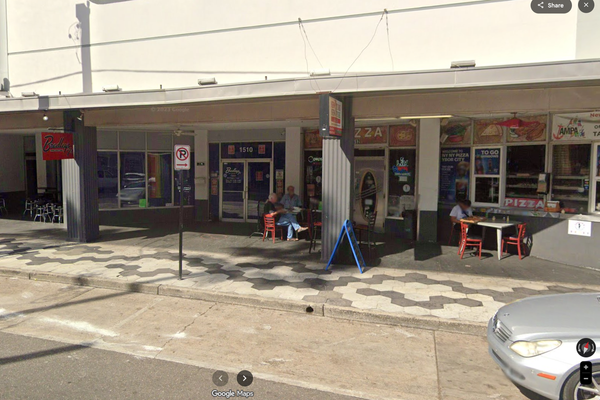
Haute couture, the most exclusive and expensive kind of clothing, can be a keen barometer for the shifting tastes of the uber-rich. What does it say that this season jeans are a recurring theme? Or rather, the illusion of them. A dupe without the bargain price tag, these “non-denim” jeans feature luxurious materials and intricate techniques that combine to create garments that look like denim, when in reality they are anything but.
The trickery started last year with Bottega Veneta under Matthieu Blazy. His spring 2023 ready-to-wear collection featured Kate Moss wearing “jeans” made entirely of leather, printed with photo-realistic “denim” detailing. Predictably, they caused a stir.

This season, beleaguered house Balenciaga continued the illusion theme at its haute couture presentation in July, showing “jeans” and jackets made of cotton canvas intricately painted with oils. The pants will reportedly retail for $27,000 (£21,000). Meanwhile Julien Dossena, the latest guest designer to show under the Jean Paul Gaultier mark, created glimmering jeans made entirely out of beads.
Sparkle is also a priority for Valentino under Pierpaolo Piccioli, where haute couture “jeans” have been constructed from silk gazar – a kind of thick organza – embroidered with minuscule beads, dyed in different shades of indigo to mimic the variegation of denim. The jeans took four weeks to make by hand, Piccioli wrote on Instagram.
Jeans styles swoop in and out of popularity, particularly where fit is concerned. Recent years have seen spray-on skinny jeans give way to baggier styles with relational names – the “mom”, the “boyfriend” – and lately, the improbable return of low rise.
But in all this movement, the position jeans hold as a foundation of modern wardrobes hasn’t much wavered. What other relics of 19th century fashion have followed us to this day? (The jean was, after all, invented by Levi Strauss in 1873.)
Jeans originated as a kind of labourers’ workwear, “worn by miners, farmers and factory workers, largely because they were hardwearing and sturdy”, says Harriette Richards, a lecturer in fashion enterprise at RMIT University.
“The association with social class was built into jeans from their very invention … made for blue-collar working-class men. White-collar middle and upper classes wore wool or cotton tailored trousers or slacks.”

This changed in the 50s. Counterculture evolved denim’s image and commercial culture quickly capitalised. Marlon Brando and James Dean did their bit to help: jeans were suddenly cool. In the 60s, they became the unofficial rock star uniform and in the 70s, they were minced and shredded to outfit punks.
“Throughout these periods, jeans were still associated with the working class,” says Richards, “but they were representative of nonconformist lifestyles.”
“Denim has always been a rebellious garment,” agrees Mohsin Sajid, a designer and historian specialising in denim. “There are stories of Bing Crosby getting kicked out of a hotel just for wearing a pair of jeans. It’s always been a great way to make a point.”
It wasn’t until the 80s, with an adolescent Brooke Shields in Calvin Klein advertisements and Claudia Schiffer modelling for Guess, that jeans became a status symbol – “something aspirational for the middle and upper classes”, Richards says.

Since the mid-2000s, almost every major fashion brand has shown jeans in some form, but fashion’s denim experiments have typically been confined to washes, bleaches and embellishments.
This new push to make jeans that aren’t even jeans any more feels like a step in another direction, says Sajid. “[Valentino’s] bead garment, for example – from far away, it looks like a pair of [Levi’s] 501s. Then you look closely and it’s thousands and thousands of beads.
“If you look at a pair of jeans from 1922 and a pair from this year, they’re not that different. They haven’t evolved very much. But that’s exactly what designers are tapping into. They can’t justify using actual denim – not when you can buy a pair of jeans from Uniqlo for £40. So they justify showing denim by … making a garment that looks like denim from far away, but it’s not.
“Because how else would it survive?”
Richards, meanwhile, sees the rise of non-denim as part of a macro moment: “quiet luxury”. “In this time of economic and environmental crisis, the spectacle of ostentatious fashion is seen as garish, even offensive,” she says.
Valentino’s answer to this question – the same one that underpins every luxury show that happens in the backdrop of chaos: how do we create when the world is burning? – was to work complex haute couture techniques into the ultimate everyman’s garment.
Denim is humble, even subtle. Never mind that Valentino’s version is as difficult to attain and painstaking to manufacture as a ballgown. “While these exquisite garments are no less time-consuming to make or expensive to buy, they have the illusion of accessibility,” Richards says.
Leather disguised as denim, silk masquerading as the original working-class uniform – it’s a secret shared between a designer and a wealthy wearer. An expression of luxury for a world in which luxury is a little taboo. If you know, says the pair of “jeans” that unexpectedly shimmer when they catch the light, you really know.







